Although there are now a variety of digital cameras available that can take amazingly beautiful pictures, A huge number of children are involved in drawing landscapes. This interesting activity will give young people the joy of their creativity and make them look at nature differently.
Only while drawing can a child notice what a wide spectrum of colors the world is made up of, and this is what will help to comprehend beauty and subsequently recreate it on paper.
Tips for Beginning Artists
It is not difficult to draw a landscape, but when writing it, you need to understand some nuances. Beginning artists during their first works notice that objects located in the background want to be depicted in colder tones than those located in the foreground.
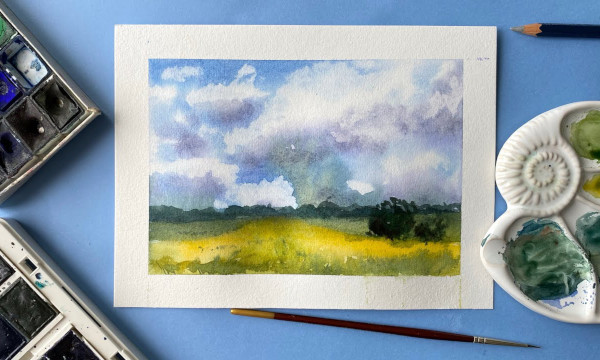
For example, the mountains in the background of the painting, despite being covered with green forest, appear blue, unlike the forest located nearby.
When drawing a landscape, it is noticeable that objects in the background do not have individual details, they are blurred, unlike those located nearby. This is especially noticeable when painting a picture with paints.
An example of drawing a landscape:
| In the foreground | It is painted with a narrow brush, and small details of the drawing are depicted in a dry form. |
| In the background | It is painted with blurred strokes using a large brush, giving priority to the raw painting. |
Landscape implies the presence of different shades near and far. The foreground of the painting is always more contrasting than objects located in the distance. As you move away, the light seems darker, sometimes the dark turns back into light. Landscapes can be painted in different ways and with different tools.
You can use:
- charcoal pencils and sticks;
- graphite pencils and ink;
- felt-tip pens and gel pens;
- feathers and ballpoint pens.

If you compare graphite pencils with ink, it turns out that it will more accurately convey the tonal differences of the graphic landscape. Actions or movements in paintings are usually drawn with felt-tip pens. In nature studies, various painting materials are used, most often acrylic, oil or watercolor paints.
Acrylic paint is suitable for absolutely any paper, it is quite easy in terms of technique, so it is actively used for painting landscapes. These paints are used as a color background for oil and gouache paints.
Quite often they are used to indicate accents in a painting.
An important point when painting a landscape is the state of the work depicted in the painting, which can change the color of the painting. This is a very important point, and if it is missed, the painting will not convey the mood of nature, and it will be deprived of its special charm.
The painting should not be overloaded with clouds, because the sky can serve as the main background of the painting and will give it a certain mood. When determining the color composition of the work, it is necessary to take into account the fact that most often the sky is painted lighter in relation to the earth and water.
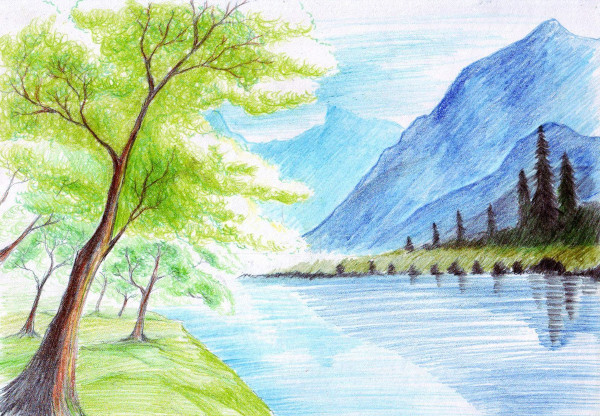
Drawing clouds also has its own special features. In relation to the sky, a light-colored cloud will seem snow-white and light. In relation to other clouds with darker edges, it will give the impression of being dark and gloomy.
You need to start painting a picture after you have chosen a specific landscape, usually natural objects:
- rivers, fields or lakes;
- mountains, meadows or individual rocks;
- ravines or solitary trees;
- roads stretching into the distance;
- exotic islands with their characteristic vegetation;
- the surrounding nature at different times of the year.
Drawing a landscape with a simple pencil
For those who want to learn how to draw a beautiful landscape using a pencil, there is Here are some recommendations to follow while working:
- It is recommended to use medium-hard paper for drawing;
- pencils need to be sharpened sharply, they should have different degrees of softness;
- It is necessary to prepare several erasers for different purposes.

Drawing with a pencil involves the use of hatching techniques. It is thanks to this that the drawing can become three-dimensional and a sense of reality will appear in the picture. Using this method of drawing, you can draw the shadow of trees or the reflection of bushes in the water.
To start drawing a landscape with a simple pencil you need:
- Marking the horizon line will give you a sense of where to place objects in the painting.
- Draw the main objects on the sketch, including: rivers, mountains, various objects or trees (initially with general features, then drawing in details).
- Draw small details: tree branches, bushes, stones or flowers.
- After this, work begins on the chiaroscuro using shading with a hard pencil (shadows are highlighted by shading).
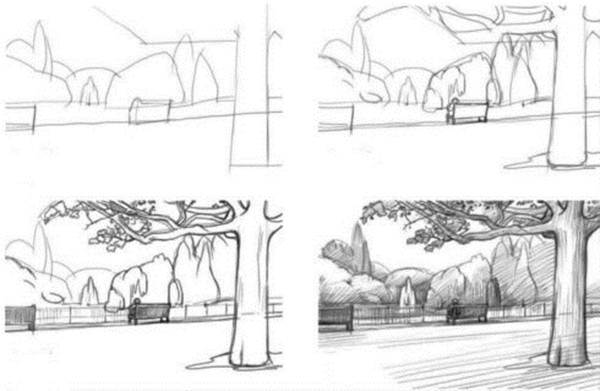
It is possible to draw a landscape quite realistically with ordinary pencils. Beginners and amateur artists can try drawing a sketch of a lonely fisherman in a boat with a fishing rod against the backdrop of a mountain range.
To make a painting sketch you need to prepare the tools:
- easel;
- pencils;
- eraser;
- sheets of paper.
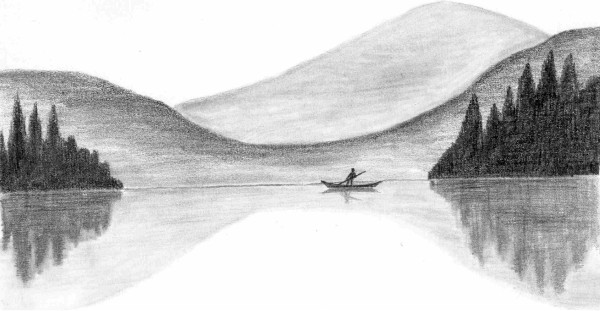
Step-by-step actions:
- The outlines of the drawing are sketched, and a horizontal line is drawn above the middle of the sheet.
- The mountain is drawn by drawing a slightly rounded triangle, which should end on the horizontal line.
- A second mountain is drawn, which begins almost where the first one ends. It is depicted as a smooth, flexible line going down.
- Next comes the shading of the mountain shadows. By the middle of the drawing it should be barely noticeable; this effect can be achieved by pressing lightly on the pencil.
- Next comes the drawing of the trees; the branches need to be shaded well, pressing hard on the pencil, thanks to which they will be visually located closer than the mountains.
- Then draw a lake, which needs to be drawn with strokes. You need to mark even stripes on both sides of the sheet and paint with sharp movements, not pressing hard on the paper, leaving the middle untouched.
- On the lake, using shading, it is necessary to apply shadows from the trees.
- At the bottom of the lake, draw a small boat; for this purpose, use the sharpest pencil possible so that the lines are clear.
- After this, the image of a man with a fishing rod is drawn in the boat.
Drawing a river and forest with colored pencils
A painting of a river and trees using colored pencils begins with the marking of a horizontal line.
After this, you need to follow these sequential steps:
- Draw the outline of the river. The river should be drawn narrow at the top of the paper sheet and wide at the bottom.

- By drawing the river area with short and long lines, the impression of its movement along the current will appear.
- You can depict irregularly shaped stones on the river, which will enhance the feeling of reality.

- After this, the boundaries of the land are sketched, trees and bushes are drawn, preferably with a wavy line, without emphasizing details.
- After this, small details of the picture are drawn, the grass and flowers growing on the shore.
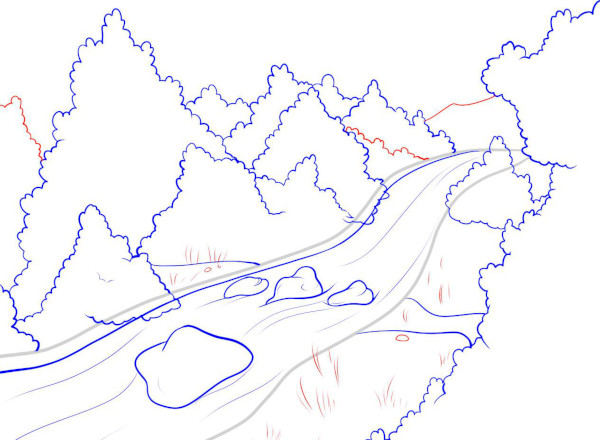
- In the background of the painting, in the corner, the drawing is complemented by a mountain with several peaks.
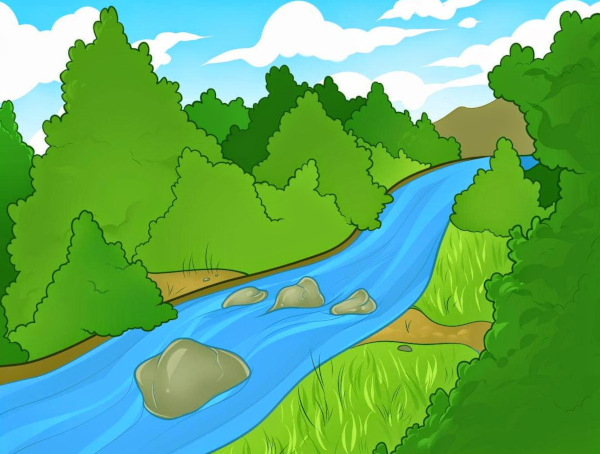
- At the very end, you need to apply the light and shadow of all objects; it is recommended to do this manipulation with colored pencils.
Drawing of a girl in a field with watercolor pencils
You can draw a beautiful landscape using pencils with leads pressed from watercolors. They are quite soft and colorful, and lend themselves well to blurring. They are quite easy to make a gradient and mix colors for a smooth transition.
To draw the image of a girl on the field you will need:
- sheet of paper;
- simple pencils;
- erasers;
- Watercolor pencils.
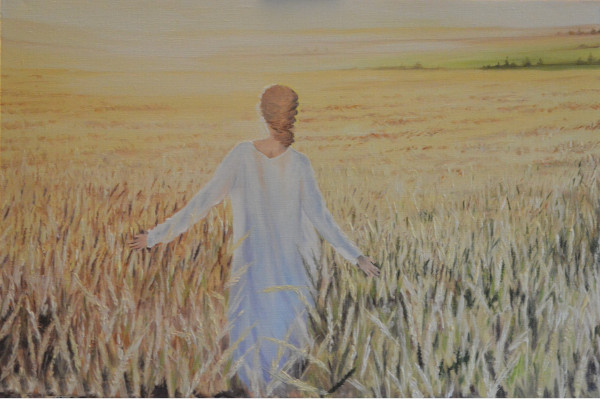
Sequential actions:
- Using a simple pencil, outline the outline of a girl in the center of the paper;
- The lower part of the drawing is drawn in beige and grey, depicting ears of corn. The drawing should be brighter at the bottom than at the top, for this you need to press hard on the pencil.
- The bottom of the drawing needs to be shaded slightly to make the shade paler.
- Next, the yellow color needs to be applied to the sky, drawing a smooth transition at the border with the horizon.
- Using a narrow brush dipped in water, you need to indicate the boundaries of objects along the application of colored pencil.
- The girl's outline can be colored in white or beige shades.
Drawing of dandelions with gouache
To make a drawing of a dandelion you will need:
- a sheet of paper in blue or light blue;
- thin brush;
- green and white gouache.
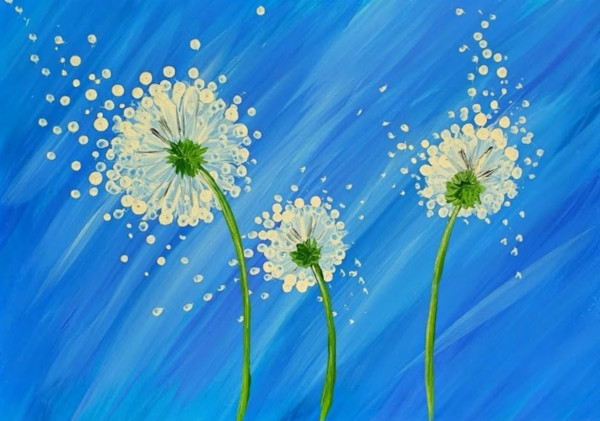
You need to take green paint with a brush and draw the stems of plants of different lengths. You can draw a wavy edge on top of the stems. After that, you should use your finger, smeared with white paint, to put small dots in a circle in the shape of dandelions.
Painting an autumn landscape with watercolors
It is quite easy to paint a bright autumn landscape with watercolors. To draw it, you will need paints and brushes of different sizes.
When drawing with small children, various additional materials can be used:
- sponges for a beautiful gradient;
- cotton swabs for drawing flowers;
- an old toothbrush to create the appearance of splatter.
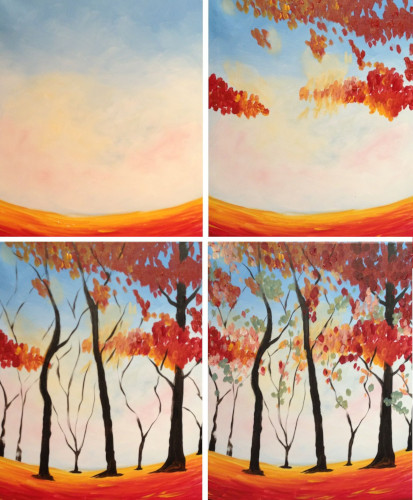
To work you need to prepare:
- sheet of paper;
- round and flat brushes of different thicknesses;
- small fan-shaped brush;
- water in a glass.
You can paint a landscape using gouache with acrylic paints of different colors:
- lilac and green;
- yellow and black;
- orange and brown.
Before starting work, you need to sketch the main outline of the drawing, then divide the paper with a horizontal straight line closer to the bottom. Then you can draw the contours of the future road in the center. The road should be made narrow at the very base, widening at the end.
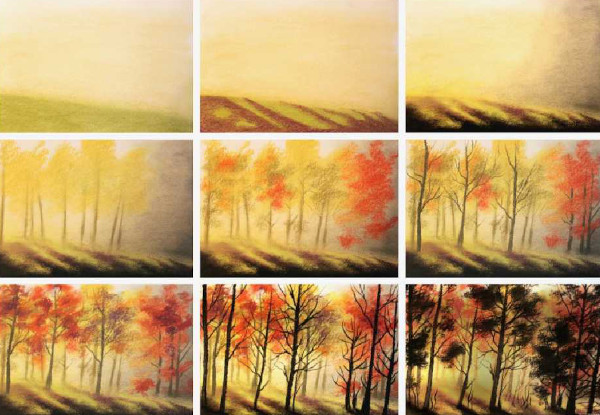
Using watercolor paint, you need to paint the sky, for which you need to wet a flat brush in water and paint with strokes. Then you need to take yellow paint on the brush and paint the sky with it, skipping the places intended for trees. A more contrasting tone should be at the bottom and in the middle of the paper.
To make the image visually matte, you can use a napkin and remove any remaining water from the drawing.
The edge of the trees should be made red, you need to dip a round brush into this shade and apply it to the outlines of the trees. This should be done very carefully, otherwise the paint may spread. For this purpose, you need to put dots at the beginning and only then connect them.
Using a flat brush, you need to pull the paint to the edge of the road, then decorate this place with a mixture of different shades. You need to make a contrast of colors by applying yellow to the edge of the lilac, towards the edge of the sheet the color should become paler.
The shadow falling from the trees can be made orange, it should be located in the center of their bases. It is necessary to make the greatest color saturation on the trees located near the artist. They should be made more contrasting, the edge of the bushes can be marked in green.
The contours of the bush can be marked in red, which will make them stand out among the rest of the vegetation. The grass should be drawn in green, sometimes diluted with orange. Thanks to this, you can get images resembling old grass.
The road borders should be painted bright orange, with wide yellow stripes on the sides. To draw light sketches of leaves on the bushes in the background, you need to apply small stripes with the very tip of the brush.
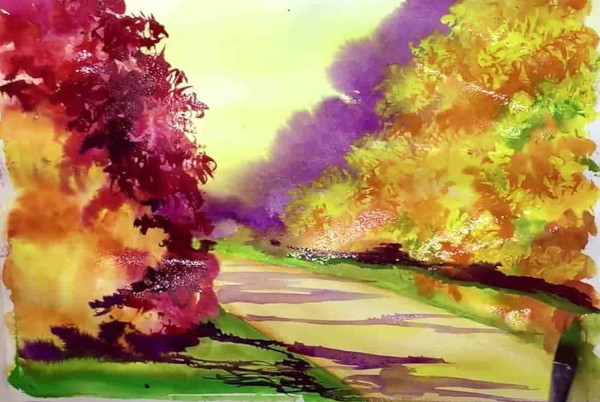
This method of painting will give absolute contrast and additional volume to the bushes, then a shadow effect should be created under them. This should be done with a dark brown color, drawing a strip along the bushes and shading it a little.
The branches should be drawn with a narrow brush, black or dark brown. It is recommended to draw shadows from forest trees on the road using lilac, they should be located in horizontal stripes, approximately repeating the shape of the bushes.
The shadows around the objects in the painting should be depicted as pale and transparent in comparison to the trees that are located far away and look bright. To obtain transparent paint, it is necessary to dilute it strongly with water. For the best result, the painting should dry on its own, naturally.
Painting a landscape with gouache
To paint a picture with gouache, a beginner does not need a large variety of shades. For such a landscape, the main colors will be enough, because by mixing the main colors, you can achieve almost any shade. Compared to acrylic paint, gouache does not require much water to dilute.

When deciding what the overall tone of the landscape will be, it is necessary to think through all stages of the work. A decision must be made regarding the presence of contrast between the light and dark areas of the drawing, and a rhythm of tonal spots is built to preserve the integrity of the sketch.
When thinking about a drawing, the distribution of light and other factors that affect the appearance of the painting are taken into account.

During preparation, the environment is observed in reality. It is necessary to understand the richness of beauty and the diversity of forms in nature. The type of the selected relief, the structure and silhouettes of trees, the shape of clouds and buildings around are taken into account. The features of the surrounding objects will contribute to the collection of detailed compositional material for a creative approach to work.
Summertime landscape drawing
To get a beautiful summer picture, it is recommended to capture the river in it. To do this, you need to draw its contours by drawing two winding lines that should start on the right side at the top of the future landscape from one line.
Further, the distance between them should increase towards the left corner of the picture. To make the river more realistic, you need to draw short curved lines in the form of a flow image.
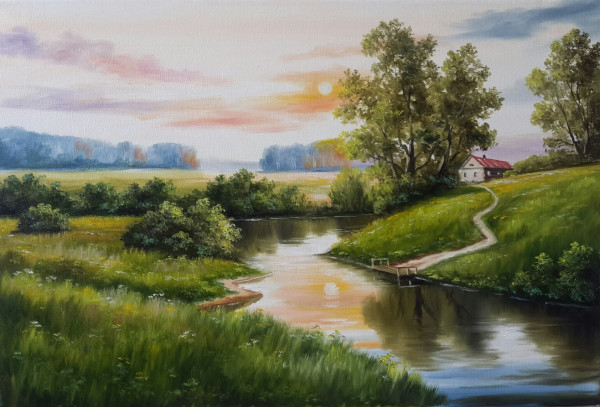
After this, it is time to outline the landscape along the river banks. Bushes can be marked with long, winding lines of different shapes and sizes. Forest paths should be laid on both sides of the river.
To make the landscape more realistic, you can add small details to the drawing:
- stones;
- berries on the bushes;
- buildings;
- birds;
- trees;
- blades of grass;
- elevations.
After making a landscape sketch, you should color the resulting picture with colored pencils, watercolors and gouache.
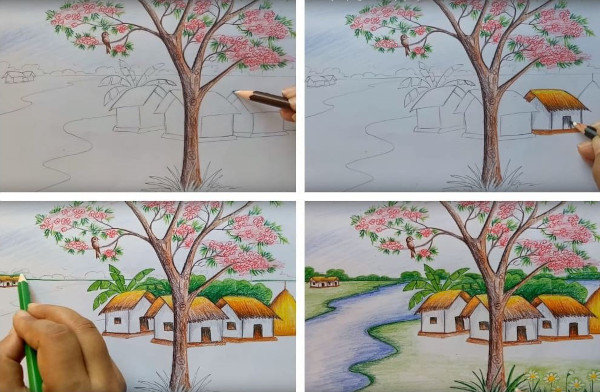
To learn how to draw beautiful landscapes, you need to start by copying the simplest images and small pictures, with a gradual transition to the most complex compositions.
It should be remembered that after applying several colors, when one shade should be superimposed on the next, it is imperative to wait for each color to dry. To speed up this process, you can use a dry stream of air, using a hair dryer.
Author: Olga Zhanskaya
Video about landscape painting
Painting a summer landscape with gouache:
